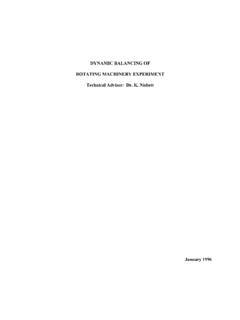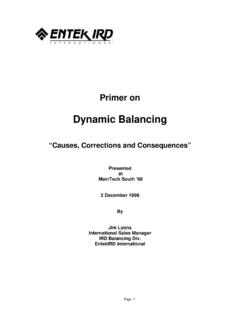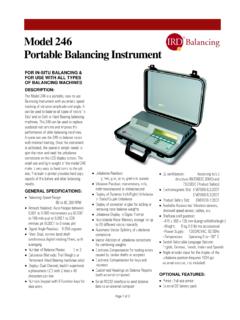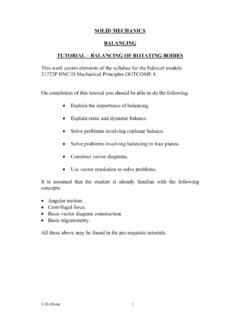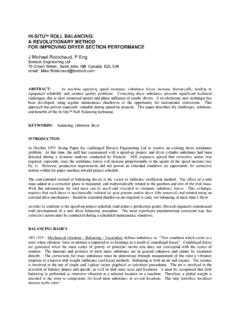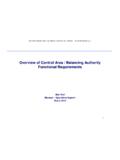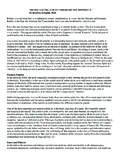Transcription of MAIN ROTOR BLADE BALANCING BLADE …
1 N750G main ROTOR DYNAMIC BALANCE J. Rivera - 9 June 2018 1 main ROTOR BLADE BALANCING BLADE alignment (See Comments on Page-11) 29 March, 2012 Recently I decided to chrome the bare steel bits and pieces on the main ROTOR due to corrosion. That meant that I would have to rebalance from scratch when the lead/lag links came back. The static balance is covered very well in the construction DVDs but I ll go over the steps I took here since they differed slightly. Before I sent the parts off I carefully measured the length of each link from the outer edge of each ball joint: Master BLADE Slave BLADE Before Chroming in.
2 In After 3-Pound Wiggle Test in. in Once they came back I reassembled the links and installed them on the two blades. Then I disconnected the pitch rod on the master BLADE and hung a 3-pound weight on the pitch arm and wiggled the ROTOR head to allow the BLADE to seek its natural position. The adjustment of the lead/lag link s length is extremely sensitive. I measured the angle of the BLADE grip using my Mitutoyo Pro 3600 digital protractor, and once I got below degrees I called that good enough and tightened the lock nuts on the link. Then I pulled the link off and measured it. It was exactly the same as before the parts went to the chrome shop.
3 That was reassuring! Once the master BLADE is done the VDV calls for you to adjust the slave BLADE by running a string from tip to tip and adjusting the slave link to make the line pass directly over the center of the top bolt, but as a test I decided to do the same 3-pound wiggle test on the slave BLADE to see what I would end up with. After repeating that process I ran a fishing line across the two blades and attached a lead weight to each end. The next step was to support the two blades so the string would pass across the top of the bolt head without too much friction and then line up the string at each end so it came off the end of the tip precisely at the junction between the extrusion and the sheet metal.
4 Here s what my initial setup looked like More reassurance that I m on the right I should mention that the small center hole on that bolt head is not in the center of the head. I chucked the bolt shank up in my lathe to make that center hole and was surprised to see that the head was not exactly centered on the shank. It was slightly off, so the hole is centered on the bolt shank but not the head. Anyway, this is awfully close but I decided to tweak the slave link to center the line. N750G main ROTOR DYNAMIC BALANCE J. Rivera - 9 June 2018 2 After a final tweak of the slave lead/lag link s length the line passed directly over the hole.
5 So now the two blades are perpendicular to each other. After pulling the link off and measuring it I ended up with a difference of inches. Doug went through all this when he checked out the ship and when I repeated the process on the master BLADE I ended up exactly where it was before (and after Doug s checkout.) He then did the dynamic balance using a weight on the side of the ROTOR head. As you ll see, I elected to remove his weight and dial out the vibration by adjusting the slave link. This probably accounts for the inch delta from where it was after my dynamic balance and where it is now after doing another static balance.
6 The next fifteen pages or so will detail my earlier dynamic balance. I had to redo it again after the chrome pieces came back, but the process was exactly the same. This second time I ended up with a final reading of ips. When you get that close you re down to small fractions of a gram of tip weight and fractions of a thousandth of an inch on the lead/lag link s length. At that point it s time to stop. The red arrows show the parts that I had chromed. And now back to my previous N750G main ROTOR DYNAMIC BALANCE J. Rivera - 9 June 2018 3 STATIC BALANCE After aligning the blades on the hub so that they re exactly perpendicular to each other the blades must first be statically balanced.
7 As the word static implies, this balance is done with the blades at rest in an area with no air movement. The idea is to adjust the tip weights to make the two BLADE tips exactly the same distance from the floor. I used a water level made from a 25-foot piece of plastic tubing for the job. Some people use a bubble level or digital protractor placed on the hub. The static balance is only the first step and does not guarantee that the blades will not cause vibrations when in motion. For that we need to do a dynamic balance. DYNAMIC BALANCE The first step necessary to do a dynamic balance is to acquire access to a vibration analyzer designed for the purpose.
8 The analyzer will provide two pieces of essential information the magnitude of the imbalance, measured in inches per second, or ips and a phase angle measured in degrees. This information will be plotted on a polar chart. The direction of the imbalance is shown in a counter clockwise direction from 0 to 360 degrees, and the magnitude is depicted by the concentric rings from 0 to ips (Figure 1.) The purpose of the polar chart (Figure 1) is to first determine where the center of mass is in relation to the center of rotation - the middle of the chart, and then allow us to adjust the main ROTOR to bring the two together.
9 In the Helicycle this is accomplished by adjusting tip weights and either adding a weight to one side of the ROTOR hub, or adjusting the slave BLADE s lead/lag link s length. Before this chart can be of use we need to develop the chart for the particular vibration analyzer and mounting arrangement to be used. I m using a Pro-Drive which is no longer manufactured. Other units should be very similar. Figure 1 Blank Polar Chart N750G main ROTOR DYNAMIC BALANCE J. Rivera - 9 June 2018 4 The two sensors that are required to measure dynamic balance are shown in Figure 2. They consist of an accelerometer to measure the amplitude of the vibration (#2), and a sensor to determine the phase angle.
10 With the Pro-Drive this is done using an optical sensor (#1) which projects a beam of light and detects the reflection off of a piece of reflective tape (arrow head.) These two sensors are connected by cables to the processor and display unit that determines the phase angle and amplitude of the vibration which it displays on an LCD screen. Since the exact placement of these two sensors affects the configuration of the polar chart I ll take a moment to go over them. The phase angle value that the vibration analyzer displays is based on where the processor is triggered by that reflective tape, and is not related to the orientation of the helicopter.

